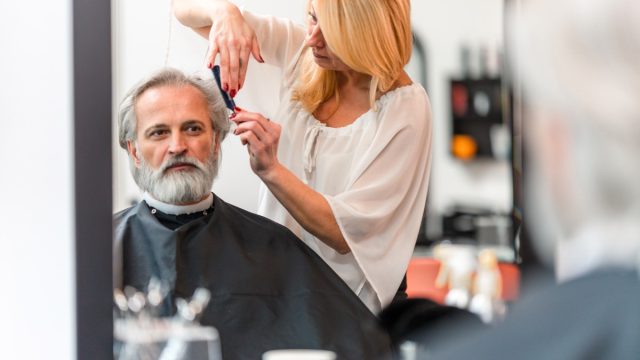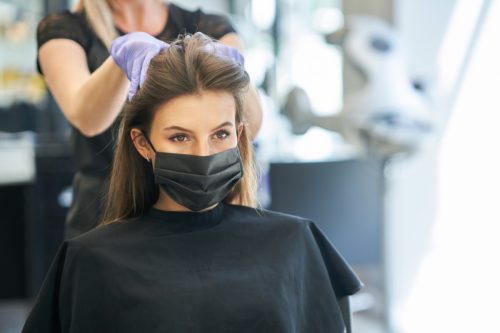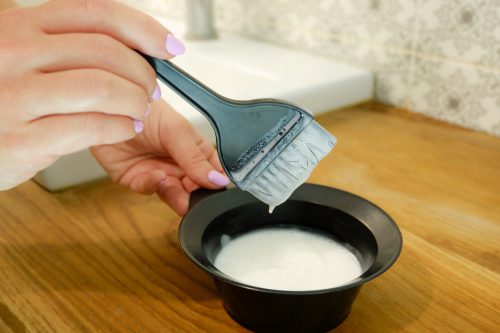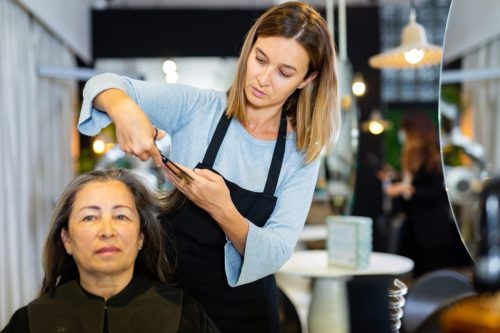5 Steps to Take Before Letting Your Hair Go Gray, Experts Say

Many people are quick to turn to hair dye when the first few gray strands show up. But this can become costly and hard to maintain over time, which might make you start wondering if you should just let your hair’s natural aging process take over instead. While embracing your gray hair can be an invigorating choice, there are also some things to consider first. Talking to the experts, we got the insider insight on what people need to prepare for when transitioning from hair dye to their natural huge. Read on to discover the five steps you should take before letting your hair go gray.
READ THIS NEXT: 5 Benefits of Letting Your Hair Go Gray, According to Stylists.
1
Ask for a professional opinion.

If you think you’re ready to give up coloring your hair, you should first talk to your stylist to actually find out what your options are. Rob Peetoom master colorist Hitomi Ikeda advises that you “always ask for professional opinions” before you go gray, so you can find out what technique is best.
As the New York-based stylist explains, “there will be several options for how you can go gray, including decolorizing, doing a series of highlight sessions, a major haircut, or just forgetting about it and letting it go.”
Talking to the professionals can help you find out what exactly you’re getting into before making this major change.
2
Decide if you want to do a gradual transition or not.

It might be overwhelming to think about going gray because the process can take quite a while. You don’t want to be caught in the in-between stage, especially if you’ve got big events coming up.
For those who don’t want to spend time growing out their gray, Kevin Murphy COLOR.ME Design Director and Education Manager Kate Reid recommends talking to your colorist about your options to “make this an easy transition without any wait time.”
But there are also options for “gradual appearance techniques to ease the transition” if you want that instead, according to Krysta Biancone, a hairstylist and the co-founder Amari Salon & Spa. “If you’re nervous about letting your hair go gray all at once, there are techniques such as frosting and lowlights that can be used to blend the silver strands with your natural hair color,” she shares.
Ian Turner, a hairstylist of over 10 years, advocates for “adding highlights or lowlights in different shades of gray to add dimension to your hair color.” According to Turner, “this will help make sure that it doesn’t look flat all the time.”
READ THIS NEXT: 10 Tips for Switching to Shorter Hair After 50, According to Stylists.
3
Consider cutting your hair.

A chop can also help make the transition easier because going gray takes less time on shorter hair. “Consider getting a major haircut or get mentally prepared to go through the stages of getting rid of colored parts of hair,” Ikeda says. And a new haircut can also benefit the entire change, according to Turner.
“If you’re letting your hair go gray, I would recommend embracing and styling accordingly by getting a professional cut that complements your overall looks,” he explains.
But Jean Lopez, co-founder of LilyHair, advises against going for “severe haircuts” such as blunt bangs and straight-edge hairstyles. “A soft bob with layers will make you look chic and youthful,” she notes.
4
Prepare to start protecting your hair more.

This transition may also require you to approach your everyday choices differently. For instance, you’ll likely need to prepare to embrace your natural texture during this time.
“Lay off hot hair styling tools. Avoid hot curling irons and hair dryers,” Lopez advises. “Hot tools can cause damage to any hair color, but it is more obvious on gray hair.”
Khamis Maiouf, a professional hairstylist for over 20 years and the founder of Book of Barbering, says you should also plan to spend less time out in the sun.
“Protecting your hair from the sun will help maintain the vibrancy of your gray hair and reduce the chances of it becoming discolored,” Maiouf explains.
For more beauty advice delivered straight to your inbox, sign up for our daily newsletter.
5
Make sure to stock up on the right haircare products.

You don’t just want your new gray hair to look great—you also want it to feel great. Ikeda recommends using “good moisturizing shampoo and conditioner to maintain good hair health” during the transition process. This is especially important since gray hair is much coarser.
At the same time, you’ll also need to make sure you’re using the right products for your hair. “Even gray hair can get discoloration,” Reid warns.
According to Biancone, there are hair products specifically meant for gray hair that can help you with that. “Purple shampoos can help balance out yellow tones and maintain hair shine,” she says.